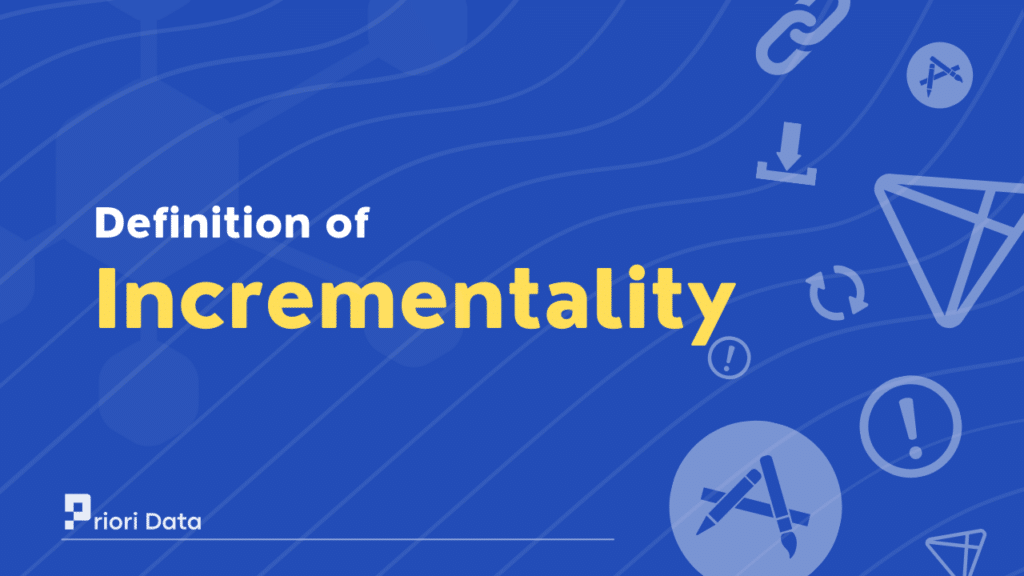The measure of the additional value provided by a specific activity is referred to as incrementally.
In terms of apps, it can refer to a rise in revenue, engagement, or other key performance indicators (KPIs).
Let’s say an app incorporates a new feature, like a personalized recommendation engine.
Incrementality refers to the increased income or user engagement that can be linked to this feature.

How do you measure such an impact?
Well, such an impact can be easily measured using A/B testing. These tests involve showing the app with newly added features to one set of users say Group A and showing the app without any change to another subset of users say Group B.
The KPIs of both these groups are then compared with each other to measure the impact.
Incrementality is an important statistic for app developers and marketers.
It helps to measure the efficacy of their changes and investments, determining whether the changes are delivering more value or merely eating up existing user behavior.
Importance of Incrementality in App Development
Incrementality is an important concept in app development for several reasons:
1. Maximizing ROI
By measuring the incremental value of different features, changes, or marketing campaigns, app developers and marketers can determine which investments are delivering the highest return on investment (ROI).
2. Improving user experience
Incrementality helps developers and marketers understand which features or changes are most appreciated by users and which are not.
This, in turn, allows them to focus on improving the user experience.
3. Optimizing resources
Incrementality analysis also helps developers and marketers prioritize their resources and efforts.
They can focus on the most impactful areas of the app, rather than spreading their resources too thin.
Enhancing competitive advantage
By measuring incrementality, app developers and marketers can identify unique opportunities for growth and optimization that competitors may not have discovered. This provides a way to differentiate themselves and offer a better user experience, gaining a competitive advantage.
Driving innovation
Incrementality analysis can also help drive innovation by encouraging experimentation and iteration, allowing developers and marketers to test new features, designs, and strategies while measuring the incremental value they deliver.
Examples of Incrementality in App Development
Here are a few examples of how incrementality can be applied in app development:
1. Feature Testing
An app developer might test a new feature by introducing it to a subset of users and comparing the results to a control group that does not have the new feature. This would allow them to measure the incremental impact of the new feature on metrics such as user engagement or revenue.
2. Marketing Campaigns
A mobile app marketer might run a user acquisition campaign with a subset of potential users to measure the incremental impact of the campaign on app installs, user engagement, or revenue.
3. Pricing Testing
An app developer might test different pricing models by introducing them to different subsets of users, measuring the incremental impact on revenue and user behavior.
4. UX/UI Testing
An app developer might test different user interfaces or navigation structures by introducing them to different subsets of users, measuring the incremental impact on user engagement and satisfaction.
5. Personalization Testing
An app developer might test different personalization algorithms by introducing them to different subsets of users, measuring the incremental impact on user retention and revenue.
Measuring Incrementality
Assessing incrementality entails comparing the performance of a test group exposed to a specific change or intervention to the performance of a control group that was not exposed to the change. The difference in performance between the test group and the control group shows the incremental impact of the adjustment.
These are some examples of common incrementality metrics:
1. Revenue
App developers and marketers can determine the incremental impact of a certain feature, pricing strategy, or marketing campaign by comparing the revenue of the test and control groups.
2. User Engagement
Comparing the test and control groups in terms of user engagement, such as time spent in the app or the number of sessions, can assist assess the incremental impact of changes to the app.
3. Conversion rates
Comparing the conversion rates of the test and control groups, such as the percentage of users who complete a specific activity, can assist evaluate the incremental impact of modifications to the app’s funnel or user flow.
4. Retention
Determining the incremental impact of modifications to the app’s onboarding procedure, personalization features, or other elements that affect user loyalty can be done by comparing the retention rates, or the percentage of users who continue to use the app over time, between the test and control groups.
5. Lifetime Value (LTV)
Comparing the LTV, or total value generated by a person during their lifetime as a customer, of the test and control groups can assist assess the incremental impact of modifications to the test group.
Strategies to Improve Incrementality
These are some incrementality-boosting methods for app developers and marketers:
1. Test frequently
By doing regular tests, app developers and marketers can iterate and test new features, designs, or marketing strategies while gauging the incremental effects of each change. This can assist them in identifying areas for improvement and avoiding costly blunders.
2. Concentrate on high-impact areas
App developers and marketers should prioritize high-impact areas of the app that have the potential to generate the most incremental value. These include onboarding, personalization, retention, and monetization.
3. Experiment with various interventions
To determine the most successful ways to produce incremental value, app developers and marketers should experiment with various interventions such as new features, pricing structures, marketing campaigns, or user experiences.
4. Utilize A/B testing
A/B testing allows app developers and marketers to compare the performance of test group A to the performance of another controlled group B. This offers a reliable approach to quantifying the incremental impact of changes.
Data should be used to guide decisions
App developers and marketers should use data to inform decisions and prioritize efforts based on the potential for added value.
Constantly monitor and optimize
Continuous monitoring and optimization of an app’s performance is crucial for developers and marketers.
They should identify opportunities for improvement and measure the incremental impact of each change.
FAQs
Ques 1: What is an example of incrementality?
Ans: An example of incrementality is the additional revenue generated by an advertising campaign that would not have been achieved without the campaign.
Ques 2: What is incrementality in business?
Ans: Incrementality in business refers to the additional value generated by a specific action or investment. It measures the impact of a particular initiative by comparing the results achieved with the initiative to the results that would have been achieved without it.
Ques 3: What is incrementality vs lift?
Ans: Incrementality is the net impact of a specific action or investment, while lift is the overall impact on a metric such as sales or customer engagement. Lift can include both incremental and non-incremental impacts, whereas incrementality only considers the additional value generated.
Ques 4: What is an incremental growth strategy?
Ans: An incremental growth strategy is a business approach that focuses on making small, continuous improvements to a product, service, or process to achieve sustained growth over time.
Ques 5: What is incrementality analysis?
Ans: Incrementality analysis is a method used to measure the impact of a particular action or investment on a business metric.
It involves comparing the results achieved with the action to the results that would have been achieved without it, to determine the net incremental impact.






